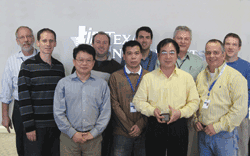TI’s CSD86350Q5D Power Block: Diligence gets cutting-edge designs to market
The industry-leading MOSFET offers new packaging, small footprint, high frequency, and low cost
The Texas Instruments CSD86350Q5D Power Block synchronous MOSFET has some impressive specs including >90% efficiency at 25 A, but then you would expect that of an Electronic Products Magazine Product of the Year winner. TI found that its customers wanted these very high efficiencies as well as high frequency, density, and ease of use for their newest power converters, especially in space-constrained server applications. The power consumed by servers and the expense associated with cooling them are significant, so being able to deliver improved efficiencies in a small foot print results in significant operating benefits. The Power Block package not only enabled faster switching frequencies or higher efficiencies for the same frequency, but also reduced space by one-half for the equivalent discrete product. It also provided a simplified PCB board layout and featured an excellent thermal solution by having a ground based lead frame.

Ten of the 15 members represent the Power Block team who needed only 18 months to develop the Power Block synchronous MOSFET platform. Rear Row, left to right Phil Bechtold, Chris Kocon, Juan Herbsommer, David Jauregui, Simon Molloy, Ron Feiller; Front Row, left to right John Duh, Jonathan Noquil, Shuming Xu, Ozzie Lopez.
The Power Block design team had to meet significant challenges on three fronts to be successful with the product. First, it was a new package structure so they had to consider all the manufacturing and field reliability requirements and then configure materials and process flows to make it cost effective. Next, they had to eliminate as many of the package interconnect parasitic resistances and inductances that would detract from the performance. Finally, the team had to coordinate and develop the new MOSFET platform to meet the reliability needs and electrical performance requirements and make it cost effective. It took a mere 18 months for a team of 15 people from several disciplines including package design, silicon device/process design, system and applications, quality/reliability, test, and marketing to get the job done.
Paul O’Shea
Advertisement
Learn more about Electronic Products Magazine





